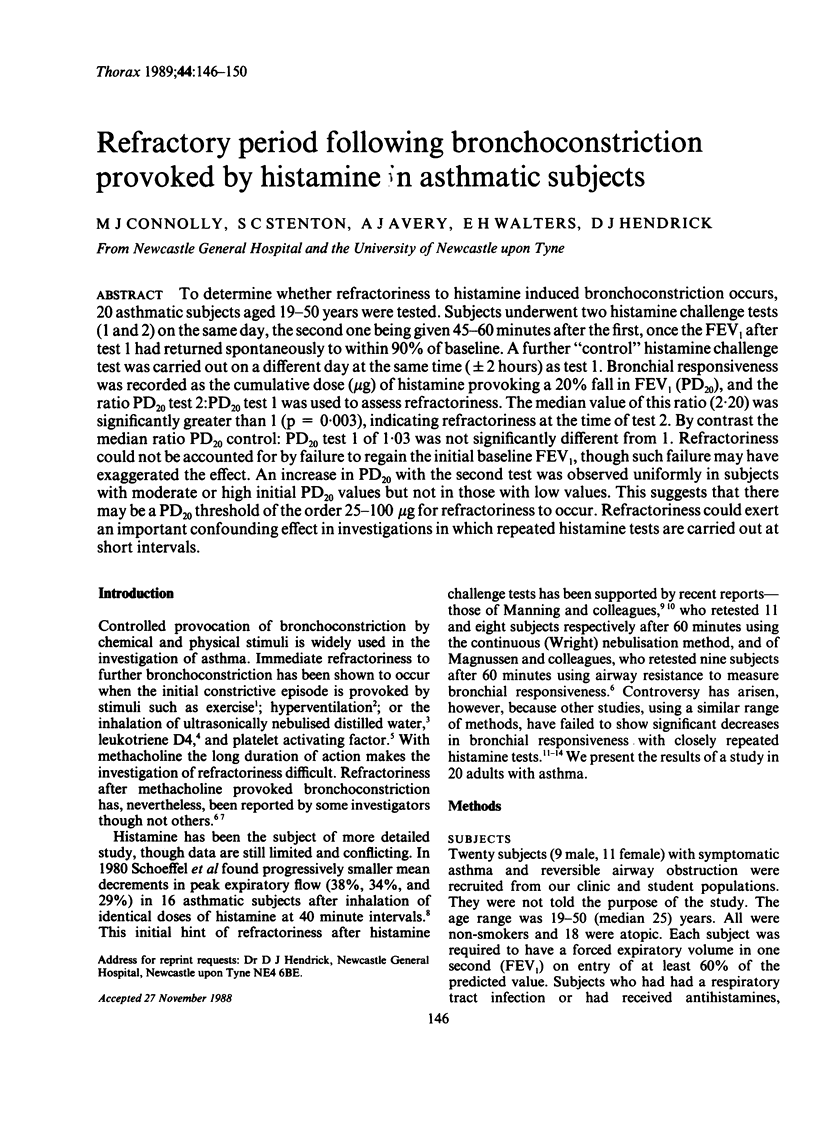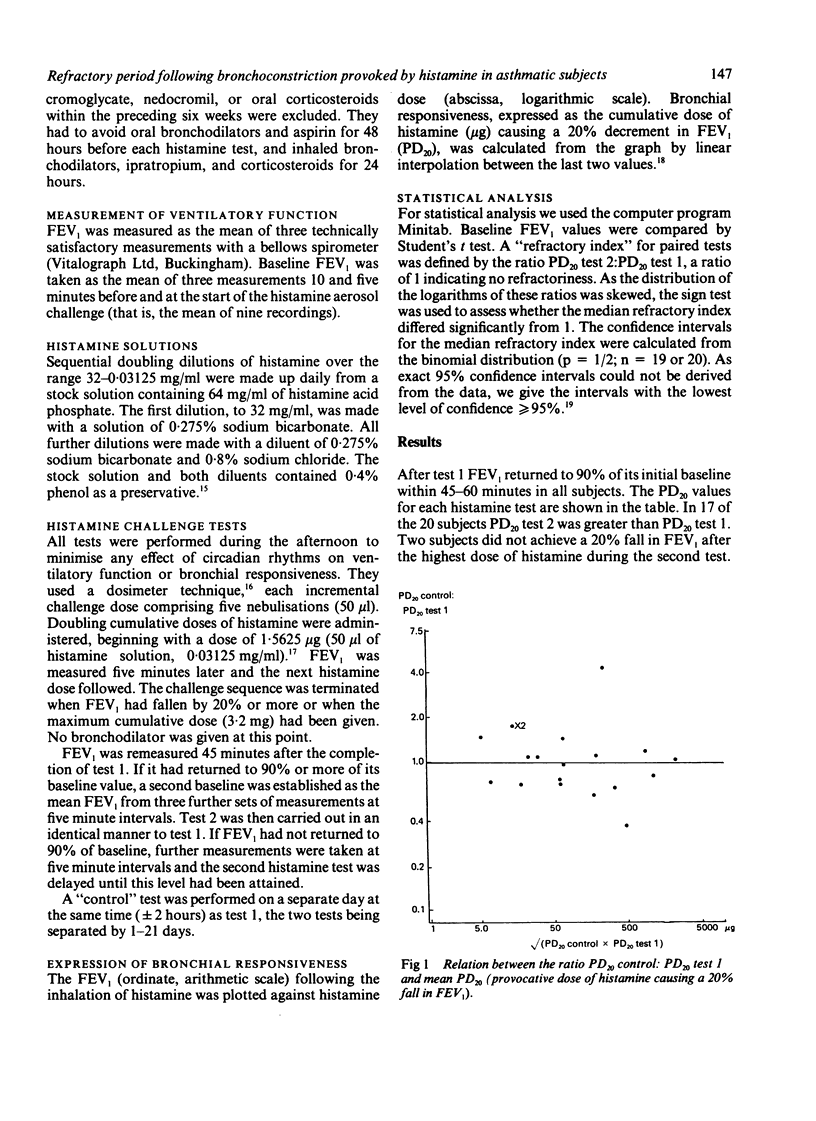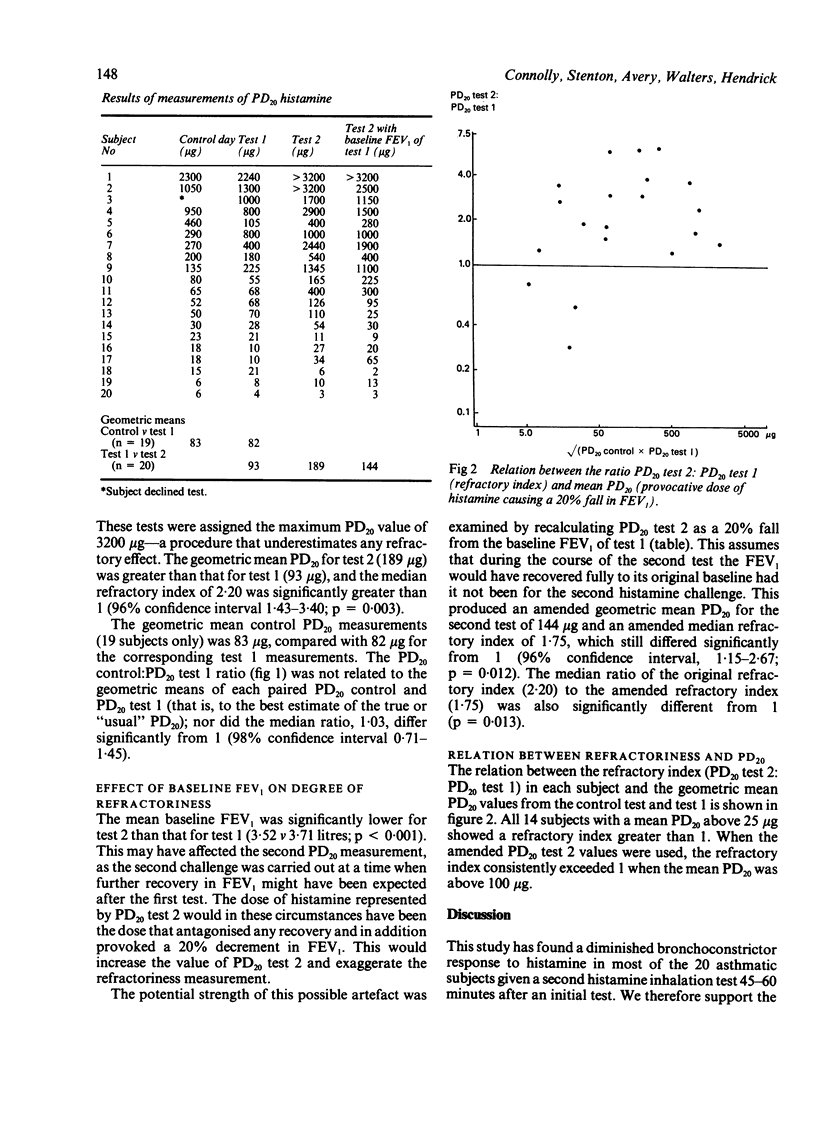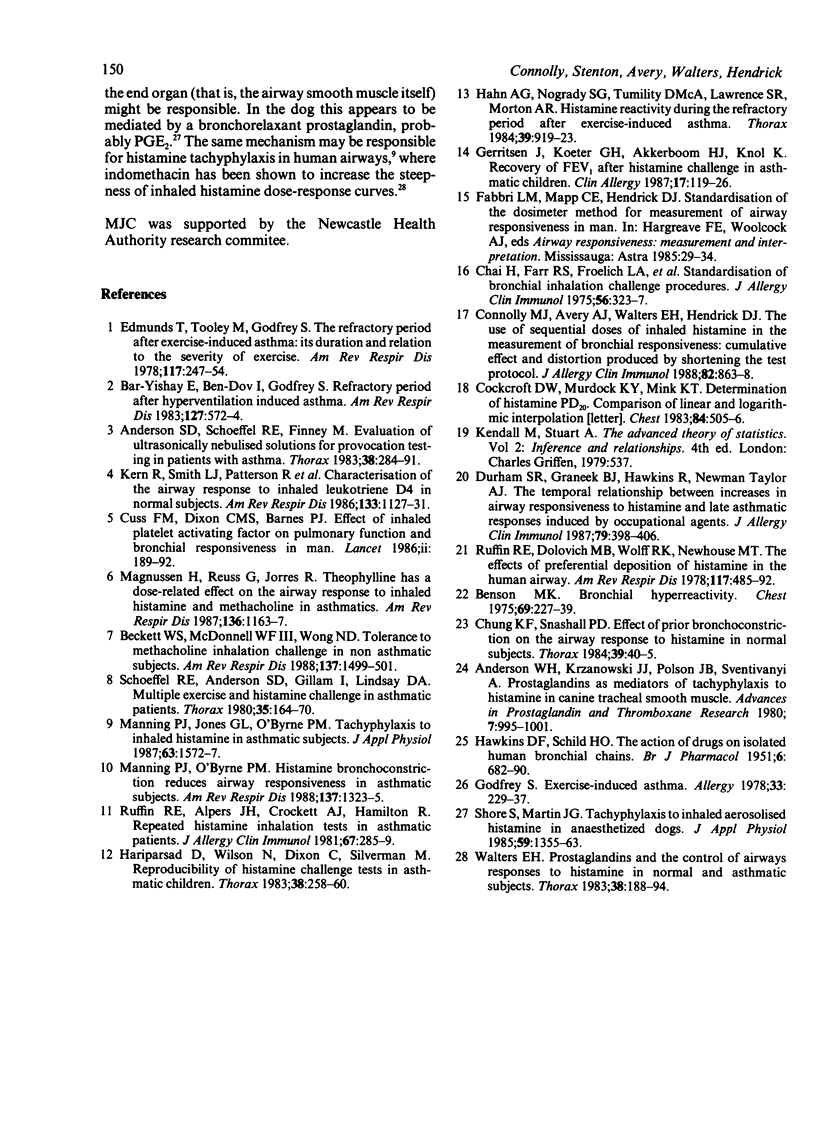Abstract
To determine whether refractoriness to histamine induced bronchoconstriction occurs, 20 asthmatic subjects aged 19-50 years were tested. Subjects underwent two histamine challenge tests (1 and 2) on the same day, the second one being given 45-60 minutes after the first, once the FEV1 after test 1 had returned spontaneously to within 90% of baseline. A further "control" histamine challenge test was carried out on a different day at the same time (+/- 2 hours) as test 1. Bronchial responsiveness was recorded as the cumulative dose (microgram) of histamine provoking a 20% fall in FEV1 (PD20), and the ratio PD20 test 2:PD20 test 1 was used to assess refractoriness. The median value of this ratio (2.20) was significantly greater than 1 (p = 0.003), indicating refractoriness at the time of test 2. By contrast the median ratio PD20 control:PD20 test 1 of 1.03 was not significantly different from 1. Refractoriness could not be accounted for by failure to regain the initial baseline FEV1, though such failure may have exaggerated the effect. An increase in PD20 with the second test was observed uniformly in subjects with moderate or high initial PD20 values but not in those with low values. This suggests that there may be a PD20 threshold of the order 25-100 micrograms for refractoriness to occur. Refractoriness could exert an important confounding effect in investigations in which repeated histamine tests are carried out at short intervals.
Full text
PDF




Selected References
These references are in PubMed. This may not be the complete list of references from this article.
- Anderson S. D., Schoeffel R. E., Finney M. Evaluation of ultrasonically nebulised solutions for provocation testing in patients with asthma. Thorax. 1983 Apr;38(4):284–291. doi: 10.1136/thx.38.4.284. [DOI] [PMC free article] [PubMed] [Google Scholar]
- Anderson W. H., Krzanowski J. J., Polson J. B., Szentivanyi A. Prostaglandins as mediators of tachyphylaxis to histamine in canine tracheal smooth muscle. Adv Prostaglandin Thromboxane Res. 1980;7:995–1001. [PubMed] [Google Scholar]
- Bar-Yishay E., Ben-Dov I., Godfrey S. Refractory period after hyperventilation-induced asthma. Am Rev Respir Dis. 1983 May;127(5):572–574. doi: 10.1164/arrd.1983.127.5.572. [DOI] [PubMed] [Google Scholar]
- Beckett W. S., McDonnell W. F., 3rd, Wong N. D. Tolerance to methacholine inhalation challenge in nonasthmatic subjects. Am Rev Respir Dis. 1988 Jun;137(6):1499–1501. doi: 10.1164/ajrccm/137.6.1499. [DOI] [PubMed] [Google Scholar]
- Benson M. K. Bronchial hyperreactivity. Br J Dis Chest. 1975 Oct;69(0):227–239. doi: 10.1016/0007-0971(75)90090-x. [DOI] [PubMed] [Google Scholar]
- Chai H., Farr R. S., Froehlich L. A., Mathison D. A., McLean J. A., Rosenthal R. R., Sheffer A. L., Spector S. L., Townley R. G. Standardization of bronchial inhalation challenge procedures. J Allergy Clin Immunol. 1975 Oct;56(4):323–327. doi: 10.1016/0091-6749(75)90107-4. [DOI] [PubMed] [Google Scholar]
- Chung K. F., Snashall P. D. Effect of prior bronchoconstriction on the airway response to histamine in normal subjects. Thorax. 1984 Jan;39(1):40–45. doi: 10.1136/thx.39.1.40. [DOI] [PMC free article] [PubMed] [Google Scholar]
- Cochrane C. G. The enhancement of inflammatory injury. Am Rev Respir Dis. 1987 Jul;136(1):1–2. doi: 10.1164/ajrccm/136.1.1. [DOI] [PubMed] [Google Scholar]
- Cockcroft D. W., Murdock K. Y., Mink J. T. Determination of histamine PC20. Comparison of linear and logarithmic interpolation. Chest. 1983 Oct;84(4):505–506. doi: 10.1378/chest.84.4.505. [DOI] [PubMed] [Google Scholar]
- Connolly M. J., Avery A. J., Walters E. H., Hendrick D. J. The use of sequential doses of inhaled histamine in the measurement of bronchial responsiveness: cumulative effect and distortion produced by shortening the test protocol. J Allergy Clin Immunol. 1988 Nov;82(5 Pt 1):863–868. doi: 10.1016/0091-6749(88)90091-7. [DOI] [PubMed] [Google Scholar]
- Cuss F. M., Dixon C. M., Barnes P. J. Effects of inhaled platelet activating factor on pulmonary function and bronchial responsiveness in man. Lancet. 1986 Jul 26;2(8500):189–192. doi: 10.1016/s0140-6736(86)92489-x. [DOI] [PubMed] [Google Scholar]
- Durham S. R., Graneek B. J., Hawkins R., Taylor A. J. The temporal relationship between increases in airway responsiveness to histamine and late asthmatic responses induced by occupational agents. J Allergy Clin Immunol. 1987 Feb;79(2):398–406. doi: 10.1016/0091-6749(87)90161-8. [DOI] [PubMed] [Google Scholar]
- Edmunds A. T., Tooley M., Godfrey S. The refractory period after exercise-induced asthma: its duration and relation to the severity of exercise. Am Rev Respir Dis. 1978 Feb;117(2):247–254. doi: 10.1164/arrd.1978.117.2.247. [DOI] [PubMed] [Google Scholar]
- Gerritsen J., Koëter G. H., Akkerboom H. J., Knol K. Recovery of FEV1 after histamine challenge in asthmatic children. Clin Allergy. 1987 Mar;17(2):119–126. doi: 10.1111/j.1365-2222.1987.tb02329.x. [DOI] [PubMed] [Google Scholar]
- Godfrey S. Exercise-induced asthma. Allergy. 1978 Oct;33(5):229–237. doi: 10.1111/j.1398-9995.1978.tb01542.x. [DOI] [PubMed] [Google Scholar]
- Hahn A. G., Nogrady S. G., Tumilty D. M., Lawrence S. R., Morton A. R. Histamine reactivity during the refractory period after exercise induced asthma. Thorax. 1984 Dec;39(12):919–923. doi: 10.1136/thx.39.12.919. [DOI] [PMC free article] [PubMed] [Google Scholar]
- Hariparsad D., Wilson N., Dixon C., Silverman M. Reproducibility of histamine challenge tests in asthmatic children. Thorax. 1983 Apr;38(4):258–260. doi: 10.1136/thx.38.4.258. [DOI] [PMC free article] [PubMed] [Google Scholar]
- Hariparsad D., Wilson N., Dixon C., Silverman M. Reproducibility of histamine challenge tests in asthmatic children. Thorax. 1983 Apr;38(4):258–260. doi: 10.1136/thx.38.4.258. [DOI] [PMC free article] [PubMed] [Google Scholar]
- Manning P. J., Jones G. L., O'Byrne P. M. Tachyphylaxis to inhaled histamine in asthmatic subjects. J Appl Physiol (1985) 1987 Oct;63(4):1572–1577. doi: 10.1152/jappl.1987.63.4.1572. [DOI] [PubMed] [Google Scholar]
- Manning P. J., O'Byrne P. M. Histamine bronchoconstriction reduces airway responsiveness in asthmatic subjects. Am Rev Respir Dis. 1988 Jun;137(6):1323–1325. doi: 10.1164/ajrccm/137.6.1323. [DOI] [PubMed] [Google Scholar]
- Ruffin R. E., Dolovich M. B., Wolff R. K., Newhouse M. T. The effects of preferential deposition of histamine in the human airway. Am Rev Respir Dis. 1978 Mar;117(3):485–492. doi: 10.1164/arrd.1978.117.3.485. [DOI] [PubMed] [Google Scholar]
- Schoeffel R. E., Anderson S. D., Gillam I., Lindsay D. A. Multiple exercise and histamine challenge in asthmatic patients. Thorax. 1980 Mar;35(3):164–170. doi: 10.1136/thx.35.3.164. [DOI] [PMC free article] [PubMed] [Google Scholar]
- Shore S., Martin J. G. Tachyphylaxis to inhaled aerosolized histamine in anesthetized dogs. J Appl Physiol (1985) 1985 Nov;59(5):1355–1363. doi: 10.1152/jappl.1985.59.5.1355. [DOI] [PubMed] [Google Scholar]
- Walters E. H. Prostaglandins and the control of airways responses to histamine in normal and asthmatic subjects. Thorax. 1983 Mar;38(3):188–194. doi: 10.1136/thx.38.3.188. [DOI] [PMC free article] [PubMed] [Google Scholar]
- Weiss S. T. Passive smoking and lung cancer. What is the risk? Am Rev Respir Dis. 1986 Jan;133(1):1–3. doi: 10.1164/arrd.1986.133.1.1. [DOI] [PubMed] [Google Scholar]


